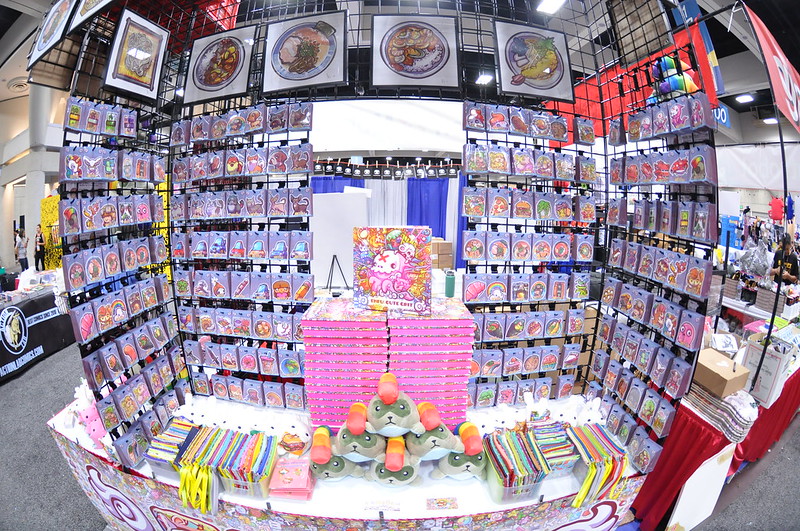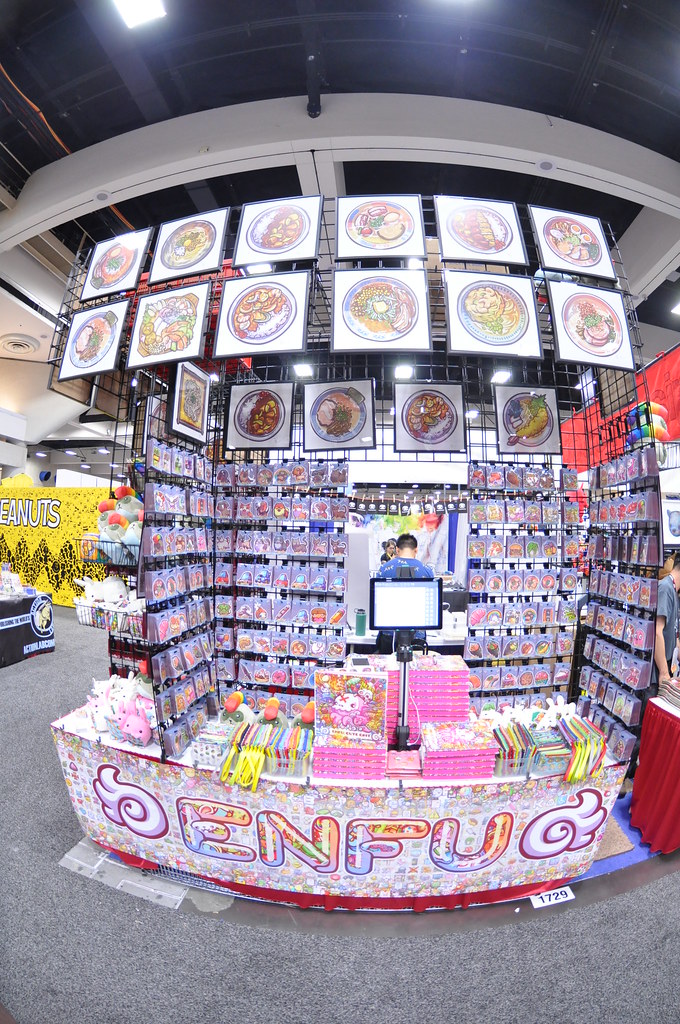Wow I've been neglecting the blog portion of this website for quite some time! Well it's time for a Comicon Recap, last year I wrote my postmortem and added to the lessons I've learned so ya'll can learn from them. If you're like, "just show me the pictures already", then here you go, here is a link to the full album.

The build up of this year so far from tabling at Sakuracon, Emerald City Comicon, and JAMAF, was to bring my new ENFU STICKER LINE to market. I enjoy AB testing these at conventions. Here are the lessons I've learned from my observations...after the jump.

1. Improve your display! Compared to last year, you'll see my set up has changed quite a bit. I've started to use grid slats and have built vertically upward. There is always room to improve, and it has improved quite a bit from last year, and there is still a long way to go. Well these grid slats were crucial to showcase the vast wall of stickers in series 1 (144). So I mapped out the table and calculated that I would have enough space to showcase all 144, 2.3 times. I needed to duplicate the stickers for the other side around the corner since crowds form and people always seem frustrated waiting for people to move. I was also able to hang picture frames on top, making them much easier to see, and just being able to show more product improved visibility overall. There are quite a lot of downsides to this display though. One of which...it takes a LOT more effort and time to set up. I had to zip tie everything and structurally make it sound, and hanging all the product took way more time. Take down takes way more time too. The grid slats are heavy and added to freight costs as well. Grids aren't for everybody, but if you're willing to put in the effort, you can improve.
2. Prices! W-F of SDCC I kept the stickers at a flat $3 each. Lots of people would ask if there was a bulk discount, but I said there wasn't. I wanted to see what the public would do. As I tallied the numbers, I would see notice that lots of people would buy in bulk anyway. Very few bought just one, and many bought sets of 3. Then there would be people buying sets of 10 or 20. But there were very few that were like sets between 4-10. So Eric from Giant Robot suggested bulk pricing. And a deal of 2 for $5 didn't seem right since I've already observed people buying 3. People needed the encouragement to buy 4, so thus the 4 for $10 price came about, and 10 for $20. The price change drastically changed the amount of product moved. This was quite a long explanation but had I not spent 3 days observing buying patterns I would have just chosen 2 for $5. So despite advising against displaying prices, I hand wrote a little sign stating the bulk deal, and it helped. I guess there are always exceptions. Testing and observing how your product reacts in the wild is valuable.
3. Networking! I'm here to meet people, and I met quite a lot of awesome inspiring people from many walks of life. A lot of connections were totally random, some were friends of friends. I think often Artists lose sight of cons and think the only measure of success or value to be there is how much money they made. Don't get me wrong, money is great, but the pouch holding all my business card contacts to me is more valuable.
4. I need an assistant! We got so busy I was losing sales. I need someone to handle sales while I'm pitching products or collaborations to people. I'm there to pitch. Often times I would walk out of the booth and stand next to the person I was pitching to while telling people in line to 'hold on just a second...'. I was trying not to be rude, but I am only one guy manning that whole section. Next year I'm bringing an assistant.
5. Plan B sometimes becomes your Plan A. The core part of my set up relied on this tall shelf in the middle. The pallet it shipped on arrived without the poles, and a few bent grids. The forklift must've caught the poles, bending them beyond repair. The freight company just chucked them, making my whole shelving plan kaputt. Had I had the shelving, I would've had lined the ceiling with plush, and had more surface area behind me to hang stuff. I had prepared a tool box and luggage completely covered in stickers as sample objects I could not display anymore. You just can't get mad at things you cannot control. Next year I will buy my own pallet with sides, and be better about shipping to reduce forklift damage. That reminds me, I gotta put in my claim.
6. Lighting is needed. The shelving was high, but it cast a shadow on itself, making me some artist lurking in the shadow of my own product. That isn't great. I have an idea of buying nice portable lights to attach to the grids.
7. Adjust your display. Day 2 I realized we had power so I set up my iPad and ran a looping video of the my pattern making tool Enfusoft. That video really caught peoples' attention. I immediately found ways to pitch to industry professionals this tool. And they saw that I wasn't just an Artist, but offered more value by saving them time. There aren't many artists out there pitching software, right? Everything helps.
8. Have great booth partners. The whole Giant Robot crew and Crayon Monsters are funny, uplifting, and full of encouragement. It really helps when you do things together. They help cover my booth when I run to my bathroom breaks, help with lots of worldly advice, and help connect you with people. I appreciate my partners in crime, I am super greatful to be able to run with them.
9. Sleeper hits. For some reason, people always suprise me. I wrote about not displaying prices and why that's important, and I've already broken my own rule. But part of the reason is I put all my prices down on a menu and hand people it. When you hand people things like books or menus, it prompts them to hang around. It has a 'sticky' value to it. That, and undecided people staring at the wall of stickers keeps people crowding around your booth. That is a good thing. The menu was so effective a couple people wanted to buy it, so I just sold it to them.
10. Remember to have fun in the moment. I stress and have anxiety months leading up to SDCC every year since the planning phase is long and what is hard. During the show, now that I've done this so long, I just now get to enjoy the party. The interacting with and connecting with people is pure fun. Getting to witness people enjoying your work is really the closing loop of creation. You spend countless hours just sitting by yourself drawing things years in advance, then spend months product developing, then packing, then logistics, then set up...then at the point of sale people get to squeel or exclaim or rub their face in it. It is a great high. Remember to have fun. I ride that high for months after the con is over. And since I do about a con every month it is quite a ride!
